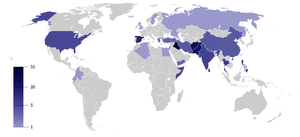“Terrorism is an anxiety-inspiring method of repeated violent action, employed by (semi-) clandestine individual group or state actors, for idiosyncratic, criminal or political reasons, whereby—in contrast to assassination—the direct targets of violence are not the main targets. The immediate human targets of violence are generally chosen randomly (targets of opportunity) or selectively (representative or symbolic targets) from a target population, and serve as message generators. Threat- and violence- based communication processes between terrorists (organization), (imperiled) victims, and main targets are used to manipulate the main target (audience(s)), turning it into a target of terror, a target of demands, or a target of attention, depending on whether intimidation, coercion, or propaganda is primarily sought.” (Schmid Alex P. and Albert J. Jongman. Political Terrorism, 1988, p. 28)
“Terrorism is illegal violence or threatened violence directed against human or nonhuman objects, provided that it: (1) was undertaken or ordered with a view to altering or maintaining at least one putative norm in at least one particular territorial unit or population: (2) had secretive, furtive, and/or clandestine features that were expected by the participants to conceal their personal identity and/or their future location; (3) was not undertaken or ordered to further the permanent defense of some area; (4) was not conventional warfare and because of their concealed personal identity, concealment of their future location, their threats, and/or their spatial mobility, the participants perceived themselves as less vulnerable to conventional military action; and (5) was perceived by the participants as contributing to the normative goal previously described (supra) by inculcating fear of violence in persons (perhaps an indefinite category of them) other than the immediate target of the actual or threatened violence and/or by publicizing some cause.” (Gibbs, “Conceptualization of Terrorism,” American Sociological Review 54, 3 (1989), p. 330)
“Criminal acts, including against civilians, committed with the intent to cause death or serious bodily injury, or taking of hostages, with the purpose to provoke a state of terror in the general public or in a group of persons or particular persons, intimidate a population or compel a government or an international organization to do or to abstain from doing any act.” (United Nations Security Council Resolution 1566 (2004))


 12:02 AM
12:02 AM
 OGB community
OGB community













0 comments:
Post a Comment